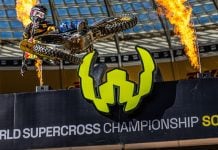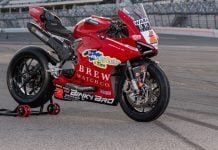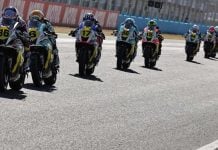FIRST PERSON/OPINION Via e-mail: I read the article about DMG’s recent meetings with the OEMs. I was pleasantly surprised to see the mention of a youth orientated spec series that would focus on the youngest of young road racers in our midst, the 12-16 year olds. I believe there is great fan interest in supporting those coming up as shown by the grassroots interest in the now defunk Red Bull AMA Rookies Cup. The true value of the Red Bull Rookies Cup wasn’t the hospitality center or the matching leathers, it was that it was a spec GP based series that allowed the showcasing of talent on an equal level, and exposure regardless of the family’s wallet. With few exceptions, anyone raising a youth racer is strapped for kind of cash it takes nowadays and a youth spec series is a great way provide another avenue besides the free-for-all that represents the 125GP racing today. I do have serious concerns about the choice of bike mentioned in relation to the youth racing, the heavy and slow Kawasaki Ninja 250. While it may appear to be an ideal choice initially, it loses its attraction after you dig into the wider factors at play in youth road racing. The racers likely to participate in a national youth spec series are not beginners. These racers have years of experience on GP equipment. In 2008 alone, my son Peter turned 3500 miles on a racetrack. These racers have aspirations of professional racing and train for it. The bike should be suited to that end. The Ninja 250 was designed as a beginner bike for new adult riders, the bike’s overbuilt construction reflects that novice purpose. The youth racers aren’t small in skill, just stature. Most youth racers today are small people and some of the most skilled racers are down right little. Several of the top 125GP riders running the USGPRU or WERA 125 Nationals are barely over a 100 pounds, several including my son Peter are under 4’10″ and just tip the scale around 75 pounds. The 125GP bikes they currently ride weigh in at 160 pounds, roughly twice the weight of a youth rider. Given the weight of adults, that 1:2 rider to bike ratio is about the same ratio as adults to a modern sportbike in race trim. I firmly believe that the Ninja 250 is unsuited to youth racer development. The Ninja 250 specs say it weighs 331 pounds dry in street trim. It would be irresponsible to expect young racers to handle a 331 pound bike safely. It is equivocal to an adult racing a 780 pound bike, dry. The cockpit of the Ninja 250 is also made for an adult, making the reach to the controls adult length, which would prevent some youth racers from even being able to ride across a parking lot, let alone race it safely. Beyond the weight issues, the Ninja 250 fails on another nearly equally as important front, in that it is not a platform designed to train riders to become better race craftsman. There are significantly better bikes to consider, some already have major OEM contingency, that are specifically designed for road courses, are more suited for youth-sized riders and are already racing in an existing spec series with a talented youth racing community already behind it. I am specifically referring to the purpose-built Moriwaki MD250H powered by Honda and its $110,000 annual contingency. Weighing it at 198 pounds with a sophisticated chassis, fully adjustable suspension, race focused components, lightweight wheels with readily available race spec tires, this is the real deal. The Moriwaki spec class currently with the USGPRU and is a favorite with the fans as it produces very close racing, lots of passing, and the ability of the rider shines through. Focusing on youth riders ages 12-16 is also the intent behind Honda’s introduction of the bike to the US two years ago, presenting an opportunity aligning DMG’s efforts with the community and to partner with a major OEM, while satisfying the monetary,talent level and safety needs of the racers. The MD250H use Moriwaki spec CRF250X motors with solid, proven engineering and are low maintenance. Even in spec form, the bikes are near to 125GP speeds and equivalent in weight and cockpit design thus making them a natural fit for youth racers to best hone their skills. The best part is that because Honda is behind the program, in several cases the cost of the bikes were repaid in the quickly through contingency with earnings left over to cover other racing expenses. The MD250H and its support from American Honda makes for safer, proven, pro-level racing. Come to think of it, the Moriwaki MD250H powered by Honda is very similar to the new MotoGP Moto2 class. There is no way this class would be confused with any other class on the track. One other thing I wanted to touch on was the mention of a pay to ride program. There is no way that my son Peter would be racing now if it wasn’t for the support of his sponsors and fans. Sponsors help us put Peter on the track through product. Youth road racing isn’t like motocross where there is a cash payday with product sponsorship. Mom and Dad are the number one suppliers of cash and if a youth spec series is going to costs upwards of $20k to buy a seat for a year, then majority of families, including ourselves, wouldn’t be able to do it. But most youth families today could field a bike and maintain it through the support they receive now or at the very least drum up local support for a national spec series run because it will be run at the pro level. Ideally, if DMG could arrange group transport, a single crate such as used by fly-away MotoGP races, that would take care of the major logistics/expenses and make the series all the more attainable. I want to applaud DMG for their consideration of youth racing. As a family, we would like to be able to contribute to the success of the series. To be a success, I believe the selected platform needs to reflect the targeted talent and proportion racers and be able to put on the type of show the fans want; close, honest racing. Michael Lenz Father of Peter Lenz www.PeterLenz.com Vancouver, Washington
FIRST PERSON/OPINION: A Young Racer’s Dad Says The Moriwaki MD250H Is The Best Bike For An AMA Pro Youth Class
FIRST PERSON/OPINION: A Young Racer’s Dad Says The Moriwaki MD250H Is The Best Bike For An AMA Pro Youth Class
© 2009, Roadracing World Publishing, Inc.






